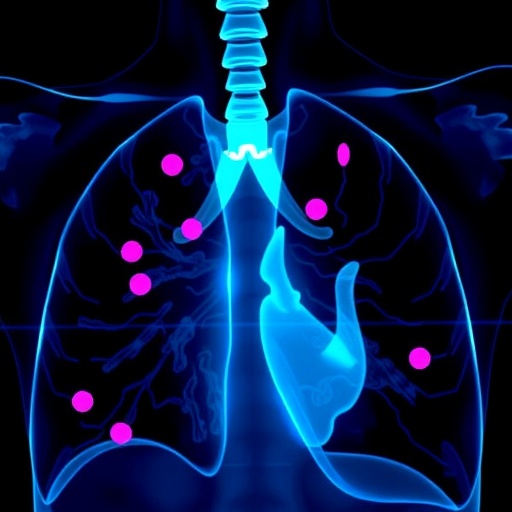Recent research highlights the potential of targeting PinX1 in the treatment of non-small cell lung cancer (NSCLC), particularly in enhancing radiosensitivity and antitumor immunity. This study, conducted by Qiu et al., addresses a critical understanding of how silencing the PinX1 gene can amplify the effects of radiotherapy. The implications of these findings are vast and could pave the way for more effective treatment modalities for patients battling this aggressive form of lung cancer.
PinX1, known as a potent telomerase inhibitor, has gained attention for its role in cellular processes, particularly in tumorigenesis. In NSCLC, where resistance to therapies often leads to poor clinical outcomes, exploring avenues to augment radiation therapies is essential. The research delves into how the downregulation of PinX1 can sensitize cancer cells to radiation while simultaneously enhancing the immune system’s ability to combat tumor cells.
Radiotherapy has long been a cornerstone in the treatment of various cancers, but its efficacy can be limited by factors such as tumor resistance. By silencing PinX1, the study proposes a novel mechanism that not only enhances the damage caused by radiation to cancer cells but also potentially boosts the immune response against tumors. This dual action represents a significant advancement in cancer therapeutics.
In the study conducted by the authors, a variety of experimental approaches were utilized to confirm their hypothesis. They implemented in vitro experiments using NSCLC cell lines to observe the effects of PinX1 silencing. Results indicated that diminished PinX1 levels correlated with increased apoptosis among tumor cells post-radiation exposure. This finding provides a robust rationale for considering PinX1 as a therapeutic target in NSCLC.
Furthermore, the investigation extended to the in vivo environment, wherein animal models were used to assess the impact of silencing PinX1 on tumor growth and immune cell activation. The outcomes from these experiments were promising, showing not only enhanced radiosensitivity but also a marked increase in antitumor immune responses. This suggests that treating NSCLC through modulation of PinX1 could usher in a new era of combination therapies.
Despite the promising results, the authors emphasize that the mechanism underlying the enhanced radiosensitivity and immune activation remains to be fully elucidated. The interplay between PinX1, DNA damage responses, and immune regulation is complex and warrants further exploration. Understanding these mechanisms will be key in translating these findings into clinical applications effectively.
The implications of this research extend beyond just NSCLC. The strategy of targeting PinX1 could have applicability in various malignancies where radiotherapy is utilized. As researchers continue to investigate the effects of PinX1 and its interactions with other cellular pathways, there is potential for this work to influence a wider range of cancer treatment protocols.
As the landscape of cancer treatment continues to evolve, findings such as those presented by Qiu et al. reinforce the importance of innovative approaches in combating drug resistance and tumor evasion of immune responses. The identification of molecular targets, like PinX1, offers new hope for developing therapies that are not only more effective but also personalized for individual patient needs.
Looking ahead, the researchers call for a multidisciplinary approach to explore the clinical implications of their findings. This includes collaboration between oncologists, molecular biologists, and immunologists to ensure that the promising preclinical findings can be translated into viable treatment options for patients.
Ultimately, this study sheds light on the intricacies of cancer biology and underscores the need for continued investigation into the mechanisms of tumor response to therapy. As the scientific community grapples with the challenges of treating NSCLC, studies like this remind us of the potential to leverage our understanding of genetics and molecular interactions in the fight against cancer.
In conclusion, the work presented by Qiu, Xia, Bao, and their colleagues highlights a promising new strategy in NSCLC treatment. By silencing PinX1, it is possible to enhance the efficacy of radiotherapy while simultaneously boosting the immune system’s response to tumors. This innovative research could set the stage for future studies and pave the way for groundbreaking therapeutic options in the realm of cancer care.
Subject of Research: The role of PinX1 in enhancing radiosensitivity and antitumor immunity in non-small cell lung cancer.
Article Title: Correction: Silencing PinX1 enhances radiosensitivity and antitumor-immunity of radiotherapy in non-small cell lung cancer.
Article References: Qiu, J., Xia, Y., Bao, Y. et al. Correction: Silencing PinX1 enhances radiosensitivity and antitumor-immunity of radiotherapy in non-small cell lung cancer. J Transl Med 23, 1017 (2025). https://doi.org/10.1186/s12967-025-07009-w
Image Credits: AI Generated
DOI:
Keywords: PinX1, radiosensitivity, antitumor immunity, non-small cell lung cancer, radiotherapy.




